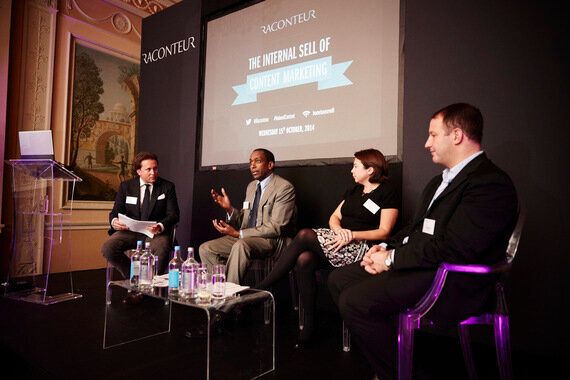
Yesterday night, Raconteur hosted 60 senior marketers and brand strategists at Home House in London to discuss the strategies behind the internal sell of content marketing. Amongst all the challenges we chat with clients about, one of the most problematic that crops up again and again is that marketers themselves have bought into the value-add and ROI of content marketing - but the effort it takes to get fellow C-suite leaders to have the imagination, foresight and mix-of "buy-in" and "hands-off" in order to execute content initiatives is burning time and money.
The aim of the evening was to note down important factors and best practice when it comes to getting support for such initiatives from senior executives. Amidst talk of editorial strategies for brands and what engaging content actually means, advice about outcomes-driven internal selling really seemed to stick - recognition that sales teams are using marketing material in their discussions and processes helps get internal buy-in and budget authorisation. Meanwhile, getting C-suites to understand the value of progress and return over time, rather than immediate metrics, is a longer but worthwhile process - and in the meantime, if possible, getting the most senior individual behind your project is a solid way to get going. Panellists Craig Welch (Wood Mackenzie) and Aimee Peters (HSBC) also brought their own experiences to the table:
Aimee acknowledged that only 50% of marketers get the resources for success, so getting buy-in from stakeholders is essential, but very challenging - "the origination of the content campaign has to be owned and endorsed at senior level, and you have to act quickly" (2013 B2B Leaders Report). She argued that for her it was recognition that sales teams are using her material in discussions that helped her secure budget, not metrics.
Craig agreed that it was crucial to get the most senior person in your organisation in a room, and get them to buy into your game plan. Only then can you get the authority you'll need with complicated processes like draft sign-offs. He is also a firm believer that "the most important metric to look at is progress over time, not immediate KPIs" despite pressure from the c-suite. "My CEO told me I was over budget on the first day of my job," he said, "people will always ask for the world, but stick to your guns". The panel discussed that it's essential to move in incremental steps - starting small with a "minimum viable product" and then once you have done so, communicate the short and long game of each initiative to the C-suite in order to manage expectations and set each initiative up for success.
Understandably, CEOs want to know how they can ensure that their content will engage, and cut through the noise proliferating online, but the room admitted that whilst they had a clear content strategy, they did not actually have a documented editorial process to ensure the projects are effective. Keynote speaker Greg Satell, author of digitaltonto.com and Forbes blogger, also took care of some myth-busting, reminding audience members that great content does not actually focus on the consumer - it's mission-driven. That's what makes it inspirational - the metrics will follow, but they should never lead: "if we only think about the numbers we forget about the mission." Ultimately, you just need to find a good story, your story, and tell it well.
Greg also outlined the problem with the traditional marketing funnel we have used for a very long time: "It has been completely blown up" says Greg, "the implicit assumption has been that the more you put in the top, the more you get at the bottom, but that assumption no longer works". Everything you do as marketers is now tracked, so if you just build awareness and walk away, you're actually helping your competitors.
The notion that brands should be establishing "emotional connections" with their audiences is perhaps the biggest myth of all - ultimately, Greg reminded us, publishing is a 'value exchange' where readers or viewers are encouraged to participate and engage because there is something genuine, authentic and interesting being offered to them - "When you're selling you can't blame the buyer for not wanting what you sell", That is the aim and should therefore dictate the game-plan.
Within the wider context of the evening's agenda, the points raised by Greg, Aimee and Craig provided the inspiration, confidence and execution strategy with which all marketers need to go back to their board rooms in order to build a fully convincing case for the £50k-£100k spend or whatever budget it takes in order to create projects that stand out above the noise. I think that a mix of the advice and strategies raised, plus a convincing 'go big or go home' attitude (of which I am a firm believer) are the best starting-line ideas for how to make the 'internal sell' work - the rest comes when stakeholders from across the business, the industry, the client dream list - and even competitors - come with their congratulations and applause, and their envy for your strategy.
Freddie Ossberg, Managing Director